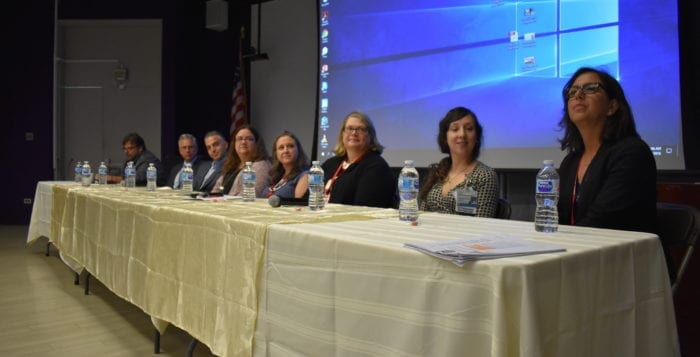The opioid crisis has reached its tendrils out to touch every person in the U.S., and the doctors who prescribe those opioids for pain relief see the ethical dilemma; whether they should treat their patients’ pain or not out of concerns of misuse.
At an opioid ethics symposium hosted at Stony Brook University Aug. 3, Dr. Kevin Zacharoff, an expert in pain medicine and a sitting member of the Anesthetic and Analgesic Drug Products Advisory Committee of the U.S. Food and Drug Administration, said a number of doctors no longer prescribe opioids for pain management because of how quickly the repercussions of misuse will come down on them.
“All the regulatory agencies are coming down and tightening the screws of people in primary care, and people in primary care are saying ‘I wash my hands of it,’” Zacharoff said. “This is all falling on the shoulders of health care providers — when people dying from heroin and fentanyl has overtaken pain medication.”

The U.S. Department of Health and Human Services reports that nationally 116 people a day died from opioid-related drug overdoses in 2016. A U.S. Centers for Disease Control and Prevention report released in 2016 said that the rate of death from drug overdoses has increased 137 percent and a 200 percent increase in the rate of opioid overdose deaths from 2000 to 2014.
CDC data shows that regulations on prescription opioids restrained the rise of overdose deaths involving legal drugs, but since 2011 there has been a spike in the number of deaths caused by illicit drugs such as heroin and other painkillers including fentanyl. Zacharoff said he fears that these regulations on opioid prescribing pushes stable patients who could have been using opioids to treat long-term pain into using illicit drugs.
“Prescription drug monitoring programs have made a positive impact, but they have also had a negative impact on health care providers, because it takes a lot of time and energy,” Zacharoff said. “Should we sacrifice our care for patients for the sake of people using the substances illicitly?”
For the past several years federal agencies, as well as state governments, have started to restrict the number of opioids available for pharmacies as well as scrutinizing how doctors prescribe that medication. A large number of federal agencies, such as the CDC, the FDA, the Drug Enforcement Administration, just to name a few, are involved in opioid research and regulations. This is on top of state prescription drug monitoring programs, which make doctors fill out forms on patients, saying whether they informed them of the dangers of the drugs and whether they asked if there was a person in the house with a history of addiction.
In April, Attorney General Jeff Sessions announced that the DEA would propose setting more limits on the numbers of opioids that a drug manufacturer could produce. Prescribing doctors said they have seen multiple problems with a shortage of opioids due to these limits on manufacturing and distribution.
“We are seeing an inability to get our prescriptions filled on Long Island,” said Laureen Diot, a nurse practitioner from East Patchogue.
Though that is not to say there have not been bad actors. In May, Merrick doctor Michael Belfiore was convicted of prescribing hundreds of opioids for profit and for causing the deaths of two men via overdoses. He wrote 5,000 prescriptions for 600,000 pain pills between January 2010 and March 2013, but Belfiore is asking a federal judge to dismiss the case, saying it was the pharmaceutical companies who promoted the drugs while downplaying their risks.
The issue, Zacharoff said, stems from doctors’ lack of education when it comes to pain medicine. A 2011 study in the National Academies Press showed that out of 117 U.S and Canadian medical schools only four U.S schools offer a required course on pain.
“That’s despite the fact that pain is the most common reason people seek medical attention,” Zacharoff said. “Doctors will often say to me, ‘I have to think about hypertension, diabetes, heart disease,’ but pain is more prevalent than diabetes, cancer and heart disease combined.”
Suffolk County officials are hoping to see a decline in the number of opioid-related deaths this year. In a report presented at the May 31 Suffolk County Legislature’s health committee meeting Chief Medical Examiner Michael Caplan said that if numbers stay low, approximately 260 opioid-related deaths are expected this year — a near 100-person decrease compared to 2017. However, the county will not know the total opioid-related deaths until the year’s end.
There are options for nonopioid pain relief, such as rehabilitative and psychological therapies. Doctors at the symposium said they expect as opioid prescribing ebbs, then other practices or drugs will become more prevalent. While some medical professionals said medical marijuana might one day work as effective pain relief, it not being legal in New York and without the necessary number of tests, the drug is not viable at this moment.
“It’s too early to write the book on marijuana for chronic pain,” said Marco Palmieri, the director of the Center for Pain Management at Stony Brook University. “Some physicians have gotten around this by opting not to test for marijuana [when doing prescriptions]. Whether that’s right, I don’t know. There certainly needs to be more data available.”





